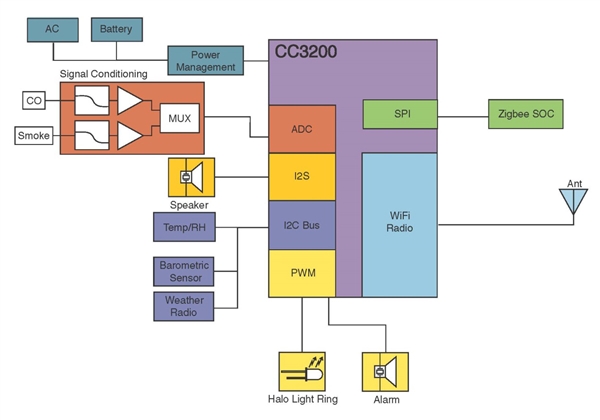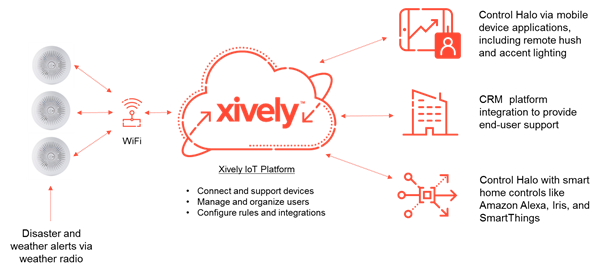SSZTA39 June 2017
Smoke alarm technology has changed little, if at all, in the past 30 years – until the Internet of Things (IoT) made connectivity possible. Realizing that smoke detectors were a natural mechanism to deliver alerts for tornadoes or other life-threatening severe weather, Halo Smart Labs used TI technology to implement its internet-enabled Halo® and Halo+ smoke detectors, which offer many new features compared to traditional smoke detectors.
Their design goals included:
- Connecting to the internet.
- Enabling end users to control their smoke alarms remotely through a smartphone or voice service such as Amazon Alexa.
- Adding carbon monoxide detection, accent lighting and alerts for approaching severe weather conditions.
- Improving basic smoke alarm functionality by providing more precise alerts.
- Eliminating false alarms, which have been a traditional weakness in smoke detectors.
Halo designed custom multisensor fire-detection logic to identify real fires faster and reduce false alarms. They also augmented the basic alarm sound system to give users greater clarity as to the precise source and nature of the threat. Their smoke detectors provide voice alerts describing the threat and use IoT connectivity to send messages to smartphones or other mobile devices. The detectors can provide voice and message alerts that specify the exact location of the alarm in a home. Halo also added a remote “hush” capability to the smartphone interface to enable users to handle any false alarms quickly.
How Halo Smart Labs Used TI SimpleLink Wi-Fi in Its Design
When Halo Smart Labs entered the search for a Wi-Fi-enabled microcontroller (MCU) solution, their requirements included low power consumption, simple Wi-Fi provisioning and sufficient peripheral input/output (I/O) ports to connect the additional logic required to implement the full feature set (Figure 1).
 Figure 1 Halo and Halo+ Smoke Detectors
use SimpleLink Wi-Fi Input/Output (I/O) Options to Integrate State-of-the-Art
Smoke Detection
Figure 1 Halo and Halo+ Smoke Detectors
use SimpleLink Wi-Fi Input/Output (I/O) Options to Integrate State-of-the-Art
Smoke DetectionThe SimpleLink Wi-Fi low-power deep-sleep mode enables the Halo and Halo+ smoke alarms to operate for up to 30 days on battery alone, while the SimpleLink SmartConfig capability enables customers to quickly and easily add any device to their home network.
Halo used the SimpleLink Wi-Fi’s high-speed analog-to-digital converter module to measure multiple sensors and voltages in their custom multisensor fire-detection technology. To implement natural voice alerts about emergencies, Halo stored the voice messages in the SimpleLink file system and streamed out the alerts to a speaker using a combination of Ultra Direct Memory Access (UDMA) and I2S communications. The SimpleLink Wi-Fi I2C ports connect the weather radio and sensors such as temperature and barometric pressure. To support Zigbee-based smart home platforms such as Samsung SmartThings or Iris by Lowe’s, Halo used the Serial Peripheral Interface (SPI) port to connect a zigbee network co-processor. The pulse-width modulation (PWM) and general-purpose I/O (GPIO) drive the accent lighting, smoke and carbon monoxide detection LEDs and the alarm itself, while providing tamper detection.
In addition to their need to support these new product features, other key factors in Halo’s decision to base their design on SimpleLink Wi-Fi were TI’s ability to provide excellent engineering support and its product roadmap, especially its support of smart home ecosystems. Halo Smart Labs is already using the recently released CC3220 device and SimpleLink software development kit (SDK) in new designs. SimpleLink Wi-Fi is certified for use in Apple HomeKit devices and Halo is currently designing HomeKit-compatible offerings to add to its product line.
In addition to using SimpleLink Wi-Fi, Halo’s design takes advantage of TI’s broad device portfolio, which also includes the CD4051BPWR analog multiplexer/demultiplexer, TLV1117LV33DCYR voltage regulator, and LMV793MA/NOPB and LMC6061IMX/NOPB operational amplifiers.
The Xively IoT Platform
A second key technology component of the Halo connected smoke detector was the Xively IoT platform, which enables companies to connect devices, structure product data to make it actionable, and integrate data with other business ecosystems.
Halo required that its connected smoke alarm and associated IoT service offer very high reliability to ensure that alerts on life-threatening situations would always get through. Halo also needed the IoT platform to scale to hundreds of thousands of users and be available for the entire life of the smoke detector. Given the investment and time that would be required to build and maintain an IoT service from scratch, Halo decided to base their design on the Xively IoT platform. This platform had been independently tested to provide very high availability and previously used in IoT applications with large numbers of users.
 Figure 2 The Xively IoT Platform
Enables Control of Halo and Halo+ Smoke Detectors Through Mobile Devices or
Smart Home Ecosystems While Scaling to Manage Hundreds of Thousands or Millions
of Customers Easily.
Figure 2 The Xively IoT Platform
Enables Control of Halo and Halo+ Smoke Detectors Through Mobile Devices or
Smart Home Ecosystems While Scaling to Manage Hundreds of Thousands or Millions
of Customers Easily.Xively runs and maintains the IoT application for Halo in the cloud, enabling Halo to concentrate on the smoke detector design and implementation. Halo also took advantage of Xively’s professional services team to assist in developing key components of their connected product.
Xively’s IoT platform enabled Halo to build in the remote hush and a remote-controlled accent light features, and integrate third-party data for weather warnings. Halo used the platform’s pre-existing integration with existing smart home platforms such as Amazon Alexa and Samsung SmartThings to design in connectivity to smart home ecosystems (Figure 2).
Designing an IoT application requires developers to work with more vendors than a traditional embedded design. TI collaborates with proven IoT platform providers like Xively to ensure customers like Halo Smart Labs can successfully deliver ground-breaking products. Visit here for more information on the Halo and Halo+ smoke detectors. Start developing your own IoT project with the CC3220 LaunchPad.